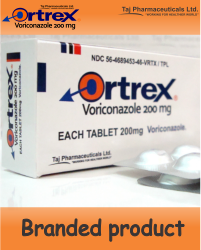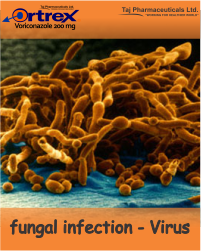FULL PRESCRIBING INFORMATION - CLINICAL PHARMACOLOGY

Ortrex Details
Contact Us
Taj Pharma India Brands
Taj Pharma Group (India)
214, Bake House, Bake House Lane,
Fort, Mumbai 400001, India.
E-mail: ortrex@tajpharma.com





CLINICAL PHARMACOLOGY
 Mechanism of Action
Mechanism of Action
Voriconazole is an antifungal drug [see Microbiology ].
Pharmacokinetics
General Pharmacokinetic Characteristics
The pharmacokinetics of voriconazole have been characterized in healthy subjects, special populations and patients.
The pharmacokinetics of voriconazole are non-linear due to saturation of its metabolism. The interindividual variability of voriconazole pharmacokinetics is high. Greater than proportional increase in exposure is observed with increasing dose. It is estimated that, on average, increasing the oral dose in healthy subjects from 200 mg q12h to 300 mg q12h leads to a 2.5-fold increase in exposure (AUCτ), while increasing the intravenous dose from 3 mg/kg q12h to 4 mg/kg q12h produces a 2.3-fold increase in exposure
During oral administration of 200 mg or 300 mg twice daily for 14 days in patients at risk of aspergillosis (mainly patients with malignant neoplasms of lymphatic or hematopoietic tissue), the observed pharmacokinetic characteristics were similar to those observed in healthy subjects
Sparse plasma sampling for pharmacokinetics was conducted in the therapeutic studies in patients aged 12–18 years. In 11 adolescent patients who received a mean voriconazole maintenance dose of 4 mg/kg IV, the median of the calculated mean plasma concentrations was 1.60 µg/mL (inter-quartile range 0.28 to 2.73 µg/mL). In 17 adolescent patients for whom mean plasma concentrations were calculated following a mean oral maintenance dose of 200 mg q12h, the median of the calculated mean plasma concentrations was 1.16 µg/mL (inter-quartile range 0.85 to 2.14 µg/mL).
When the recommended intravenous or oral loading dose regimens are administered to healthy subjects, peak plasma concentrations close to steady state are achieved within the first 24 hours of dosing. Without the loading dose, accumulation occurs during twice-daily multiple dosing with steady-state peak plasma voriconazole concentrations being achieved by day 6 in the majority of subjects
Pharmacokinetic-Pharmacodynamic Relationships
Clinical Efficacy and Safety–In 10 clinical trials, the median values for the average and maximum voriconazole plasma concentrations in individual patients across these studies (N=1121) was 2.51 µg/mL (inter-quartile range 1.21 to 4.44 µg/mL) and 3.79 µg/mL (inter-quartile range 2.06 to 6.31 µg/mL), respectively. A pharmacokinetic-pharmacodynamic analysis of patient data from 6 of these 10 clinical trials (N=280) could not detect a positive association between mean, maximum or minimum plasma voriconazole concentration and efficacy.
Electrocardiogram–A placebo-controlled, randomized, crossover study to evaluate the effect on the QT interval of healthy male and female subjects was conducted with three single oral doses of voriconazole and ketoconazole. Serial ECGs and plasma samples were obtained at specified intervals over a 24-hour post dose observation period.
Pharmacokinetics in Special Populations
In a multiple dose study of IV voriconazole (6 mg/kg IV loading dose × 2, then 3 mg/kg IV × 5.5 days) in 7 patients with moderate renal dysfunction (creatinine clearance 30–50 mL/min), the systemic exposure (AUC) and peak plasma concentrations (Cmax) were not significantly different from those in 6 subjects with normal renal function.
However, in patients with moderate renal dysfunction (creatinine clearance 30–50 mL/min), accumulation of the intravenous vehicle, SBECD, occurs. The mean systemic exposure (AUC) and peak plasma concentrations (Cmax) of SBECD were increased 4-fold and almost 50%, respectively, in the moderately impaired group compared to the normal control group.
Intravenous voriconazole should be avoided in patients with moderate or severe renal impairment (creatinine clearance < 50 mL/min), unless an assessment of the benefit/risk to the patient justifies the use of intravenous voriconazole
A pharmacokinetic study in subjects with renal failure undergoing hemodialysis showed that voriconazole is dialyzed with clearance of 121 mL/min. The intravenous vehicle, SBECD, is hemodialyzed with clearance of 55 mL/min. A 4-hour hemodialysis session does not remove a sufficient amount of voriconazole to warrant dose adjustment.
Microbiology
Mechanism of Action
Voriconazole is a triazole antifungal agent. The primary mode of action of voriconazole is the inhibition of fungal cytochrome P-450-mediated 14 alpha-lanosterol demethylation, an essential step in fungal ergosterol biosynthesis. The accumulation of 14 alpha-methyl sterols correlates with the subsequent loss of ergosterol in the fungal cell wall and may be responsible for the antifungal activity of voriconazole.
Activity In Vitro and In Vivo
Voriconazole has been shown to be active against most strains of the following microorganisms, both in vitro and in clinical infections.
→ Aspergillus fumigatus
→ Aspergillus flavus
→ Aspergillus niger
→ Aspergillus terreus
→ Candida albicans
→ Candida glabrata (In clinical studies, the voriconazole MIC90 was 4 µg/mL)1
→ Candida krusei
→ Candida parapsilosis
→ Candida tropicalis
→ Fusarium spp. including Fusarium solani
→ Scedosporium apiospermum
Susceptibility Testing Methods
Aspergillus species and other filamentous fungi
No interpretive criteria have been established for Aspergillus species and other filamentous fungi.
Candida species
The interpretive standards for voriconazole against Candida species are applicable only to tests performed using Clinical Laboratory and Standards Institute (CLSI) microbroth dilution reference method M27 for MIC read at 48 hours or disk diffusion reference method M44 for zone diameter read at 24 hours.2,3
Broth Microdilution Techniques–Quantitative methods are used to determine antifungal minimum inhibitory concentrations (MICs). These MICs provide estimates of the susceptibility of Candida spp. to antifungal agents. MICs should be determined using a standardized procedure at 48 hours.2 Standardized procedures are based on a microdilution method (broth) with standardized inoculum concentrations and standardized concentrations of voriconazole powder.
Diffusion Techniques–Qualitative methods that require measurement of zone diameters also provide reproducible estimates of the susceptibility of Candida spp. to an antifungal agent. One such standardized procedure requires the use of standardized inoculum concentrations.3 This procedure uses paper disks impregnated with 1 µg of voriconazole to test the susceptibility of yeasts to voriconazole at 24 hours.
NOTE: Shown are the breakpoints (µg/mL) for voriconazole against Candida species.
The susceptible category implies that isolates are inhibited by the usually achievable concentrations of antifungal agent tested when the recommended dosage is used for the site of infection. The intermediate category implies that an infection due to the isolate may be appropriately treated in body sites where the drugs are physiologically concentrated or when a high dosage of drug is used. The resistant category implies that isolates are not inhibited by the usually achievable concentrations of the agent with normal dosage schedules and clinical efficacy of the agent against the isolate has not been reliably shown in treatment studies.
Quality Control
Standardized susceptibility test procedures require the use of quality control organisms to ensure the accuracy of the technical aspects of the test procedures. Standard voriconazole powder and 1 µg disks.
NOTE: Quality control microorganisms are specific strains of organisms with intrinsic biological properties relating to resistance mechanisms and their genetic expression within fungi; the specific strains used for microbiological control are not clinically significant.
Activity In Animal Models
Voriconazole was active in normal and/or immunocompromised guinea pigs with systemic and/or pulmonary infections due to A. fumigatus (including an isolate with reduced susceptibility to itraconazole) or Candida species [C. albicans (including an isolate with reduced susceptibility to fluconazole), C. krusei and C. glabrata] in which the endpoints were prolonged survival of infected animals and/or reduction of mycological burden from target organs. In one experiment, voriconazole exhibited activity against Scedosporium apiospermum infections in immune competent guinea pigs.
Drug Resistance
Voriconazole drug resistance development has not been adequately studied in vitro against Candida, Aspergillus, Scedosporium and Fusarium species. The frequency of drug resistance development for the various fungi for which this drug is indicated is not known.
Fungal isolates exhibiting reduced susceptibility to fluconazole or itraconazole may also show reduced susceptibility to voriconazole, suggesting cross-resistance can occur among these azoles. The relevance of cross-resistance and clinical outcome has not been fully characterized. Clinical cases where azole cross-resistance is demonstrated may require alternative antifungal therapy.
Download Ortrex Overview
Ortrex® Voriconazole 200mg tablets are a prescription medicine used to treat certain serious fungal infections in your blood and body. Ortrex® Voriconazole 200mg tablets sold by Taj Pharmaceuticals Limited (India), a global pharmaceuticals company. It is available in India, Middle East and a few other South Asian countries.
![]() Ortrex® Voriconazole 200mg tablets_CMI
Ortrex® Voriconazole 200mg tablets_CMI
![]() Ortrex® Voriconazole 200mg tablets_FPI
Ortrex® Voriconazole 200mg tablets_FPI


 Home
Home